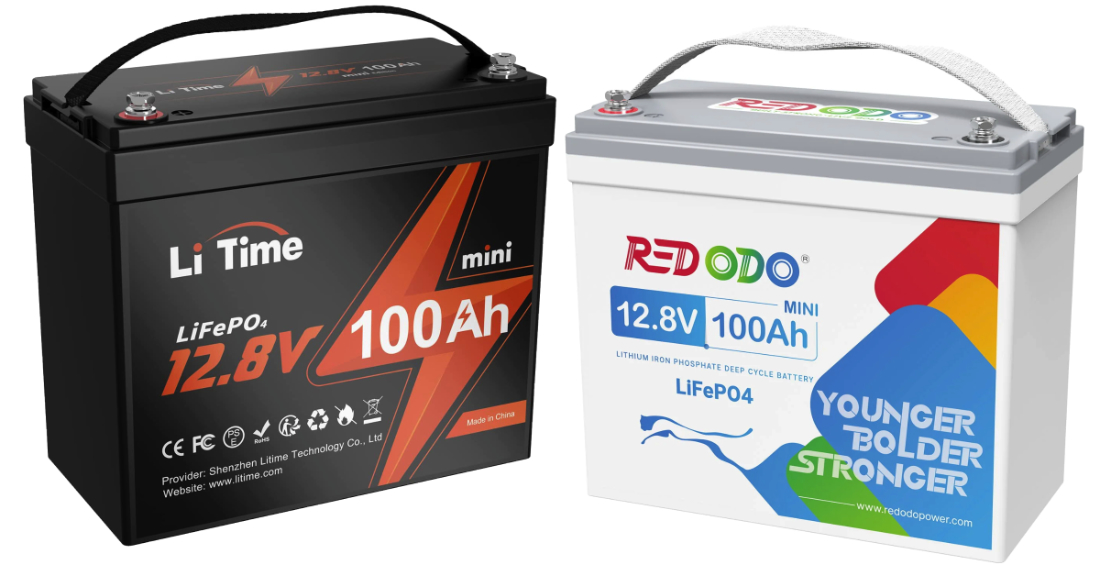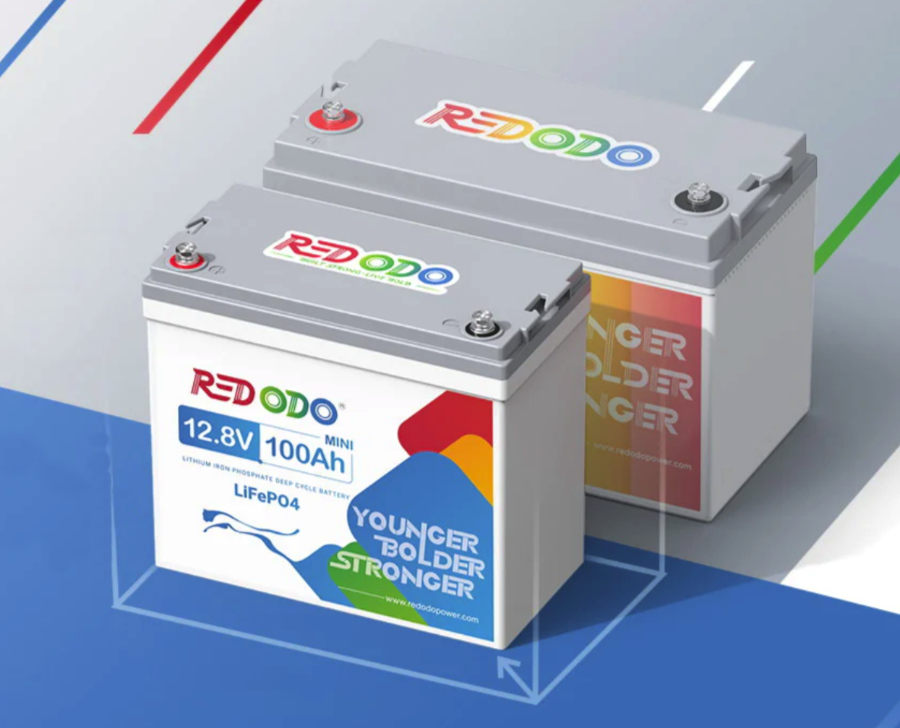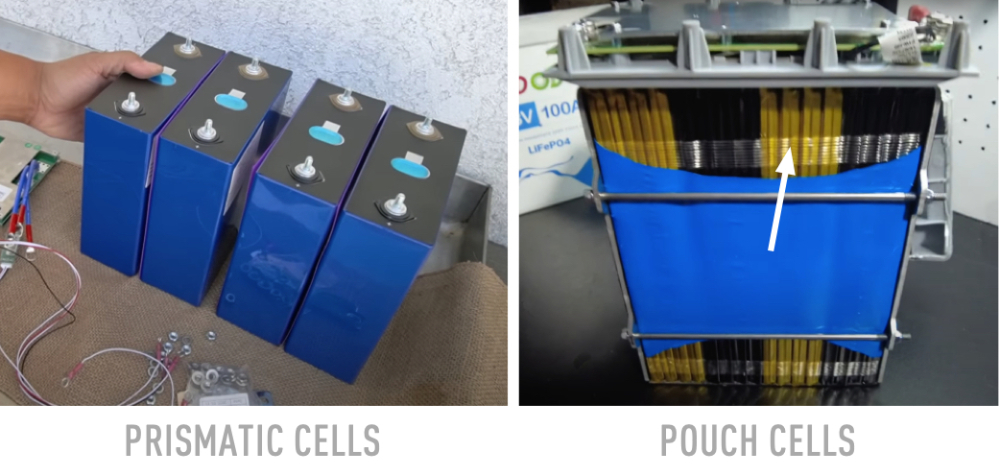
AT LEAST TWO COMPANIES that I know of have released a compact version of the popular 12.8V / 100Ah LiFePO4 battery. They’re about 2.75 inches shorter, 3 inches narrower, but about a half inch taller. Also, about 5.25 pounds lighter. Since space is always an issue for us vehicle dwellers, this is good news.

How do they do it?
If you’re like me, you wonder how they’re able to cram the same capacity in a smaller box. The main reason is that the mini versions use a different type of battery cell.

Nearly all standard 100Ah LiFePo4 batteries use brick-shaped prismatic cells. The minis use 16 thin pouch cells — the same kind of cells used in your smart phone, tablet, laptop, power bank, jump pack and such. The pouch batteries in those portable devices aren’t LiFePo4, but the ones in these 100Ah batteries are.
Pouch cells have a higher energy density — more juice per unit volume. They’re also lighter and easier to manufacture. And they’re good for three to four times as many charge cycles.
Then gee, why don’t all the off-grid LiFePo4 batteries use pouch cells instead of prismatic cells?
One reason is pouch cells can be more sensitive to temperature changes and may require additional cooling or heating mechanisms to maintain optimal performance. Prismatic cells are more stable and durable. But more importantly, they can have higher capacity.
Pros of Pouch Cells
High energy density: Pouch cells can offer a high energy density, which means they can store more energy per unit volume or weight compared to other battery cell designs.
Flexibility: Pouch cells can be made in a wide range of sizes and shapes, and are flexible, which can make them easier to fit into different device form factors.
Lightweight: Pouch cells are lightweight, which can make them ideal for portable applications, such as consumer electronics or electric vehicles.
Lower cost: Pouch cells can be less expensive to manufacture compared to other cell designs, such as prismatic cells.
Cons of Pouch Cells
Durability: Pouch cells can be less durable compared to other cell designs, as the flexible pouch can be more susceptible to damage or punctures.
Safety: Pouch cells may have a higher risk of swelling or overheating, which can lead to safety concerns if not designed properly.
Temperature sensitivity: Pouch cells can be more sensitive to temperature changes and may require additional cooling or heating mechanisms to maintain optimal performance.
Minis aren’t maxi on features
At this time, the mini batteries have only the basic features all standard size batteries do: protection from overcharge, over-discharge, over-current, and short circuiting. But, unlike higher level LiFePo4 batteries, they don’t appear to have low- and high-temperature charge and discharge cutout, and no self-powered internal heaters, the latter being almost essential if you spend any time in sub-freezing weather — especially since pouch cells are more sensitive to temperatures. Ever have your phone not work when it’s extremely cold or hot? Yeah, that. Also, these mini batteries don’t have Bluetooth connectivity for battery monitoring.
What do you think?
Is the compact size worth the tradeoffs? Had you already determined you wouldn’t need the extra features? Are you suspicious of pouch cells? Do mini batteries just complicate your decision process further?
As for me, I’m still trying to decide whether to stick with my good old lead-acid batteries or drag my butt out of the past and embrace those newfangled Lithium batteries all the kids are talking about.

Excellent! The first I’ve heard of “Pouch Cells”. We built a “prismatic” set up 2 years ago. Several surprises after getting the cells; Balancing, needing a BMS, DC-DC charger and AC-DC charger and safe packaging from around the shop. $pending on best technology I could afford, at the time, is my suggestion if entering this realm. Realize LiFePO4 specifications and assertions are not based on large samples over long periods of time like lead acid or even AGM. However, ever growing followings and enduring pursuit of specific technologies offers hope for best possible products leaving fails behind.
For my simple lifestyle the AGM Deep Cycle battery cost is still by FAR the cheapest way to go. And cost is a major item in my life.
> they’re good for three to four times as many charge cycles.
I have seen nothing in the academic or lay literature that suggests pouch configurations yield 3x-4x cycles than other form factors with the same battery chemistry. That claim sounds like someone comparing LiFePO4 to Li-NMC.
You could be right.
My source was the Redodo site (for what that’s worth) which claimed: “The compact 1/2 mini body with 2 times higher energy density, lasting longer, more stable performance and superior efficiency. Its own built-in BMS to ensure the battery safety, 10 years lifespan and 4000-15000 cycles.” The most I’ve seen other battery companies claim for their LiFePo4 batteries was 3,000 to 5,000.
15k cycles is *conceivable* with LiFePO4 in all formats, but requires careful use which the Average Customer would find restrictive:
* operation at human comfortable temps
* operation between the voltage knees (sometimes described as 20%-80%)
* gentle charging voltages like ≤3.45vpc
* gentle charge/discharge currents like 0.2C
Interestingly, Redodo’s “10 years lifespan and 4000-15000 cycles.” marketing language is not reflected in the warranty language. The latter says “5 years” (1,825 cycles).
There is a saying that ,, not anything that flies is edible”, this principle applies here too.